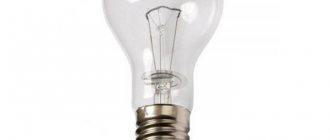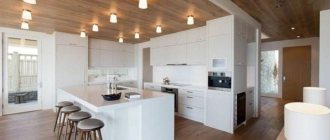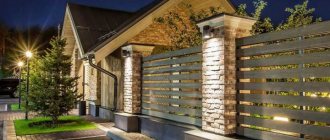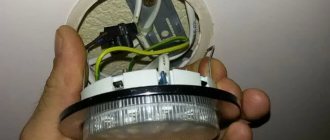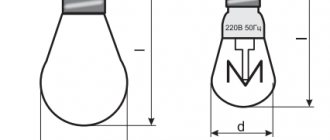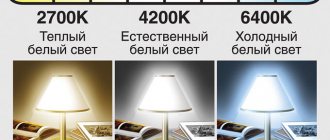Buying the right type of lamp for a lamp in a store is not such an easy task. What do you want from quality lighting first of all:
- comfort for the eyes
- energy savings
- harmless use
Type of base
Before purchasing a light bulb, it is first important to determine the required type of base. Most household lighting fixtures use two types of threaded base:
- base E-14 or minion
- base E-27
They differ accordingly in diameter. The numbers in the designation indicate its size in millimeters. That is, E-14=14mm, E-27=27mm. There are also adapters for lamps from one lamp to another.
If the lampshades of the chandelier are small, or the lamp has some specific features, then a pin base is used.
It is designated by the letter G and a number that indicates the distance in millimeters between the pins. The most common are:
- G5.3 - which are simply inserted into the luminaire connector
- GU10 - first inserted and then turned a quarter turn
The spotlights use the R7S base. It can be used for both halogen and LED lamps.
The lamp power is selected based on the limitations of the lighting fixture in which it will be installed. Information about the type of base and the power limitation of the lamp used can be seen:
- on the box of the purchased lamp
- on the lampshade already installed
- or on the light bulb itself
Flask shape
The next thing you need to pay attention to is the shape and size of the flask.
A flask with a threaded base may have:
- pear shape
- ball of different diameters
- or the shape of a candle for narrow chandelier shades and sconces
Pear-shaped ones are designated by the nomenclature - A55, A60; ball ones - with the letter G. The numbers correspond to the diameter. Candles are marked with the Latin letter - C.
A bulb with a pin base has the shape:
- small capsule
- or flat reflector
Lighting standards
Lighting brightness is an individual concept. However, it is generally accepted that for every 10 m2 with a ceiling height of 2.7 m, a minimum illumination equivalent of 100 W is required.
Illumination is measured in lux. What is this unit? In simple words, when 1 lumen illuminates 1 m2 of room area, then this is 1 lux.
The standards differ for different rooms.
Illumination depends on many parameters:
- from distance to light source
- colors of surrounding walls
- reflection of light flux from foreign objects
Illumination can be measured very easily using standard smartphones. All you need to do is download and install a special program. For example – Luxmeter (link)
True, such programs and phone cameras usually lie compared to professional light meters. But for household needs, this is more than enough.
Purchase in store
Before you go to the store, find the most comfortable lighting in your home that you want to use as a starting point. Unscrew the lamp and use its indicators to create a recipe for your light: see which characteristics suit you and which do not, and how much you want to improve them. For example, you like the color of the light, but want the brightness to be 30% more, which means the lumens should be 30% higher.
Next, with this cheat sheet, go to the store and see what lamps are available. It is better not to count on the help of the seller; he is unlikely to tell you more than what is written on the box, with the exception of the quality of the brand as a whole. If in doubt, you can agree with the manager or seller that you will make a test purchase and try the lamps at home, and return those that are not suitable.
When you experiment at home, do not forget that light affects the appearance of the interior. Take a table lamp, screw in different light bulbs and watch how your perception of the colors and textures of walls and furniture changes. The same can be done with lamps: many stores give them for trying on as a deposit.
Photos: cover – 8meg – adobe.stock.com, 1 – anyanuchoil – adobe.stock.com, 2 – eyalg_115 – adobe.stock.com, 3 – Alex – adobe.stock.com
Incandescent and halogen bulbs
The classic and most inexpensive solution for lighting an apartment is the familiar incandescent lamp, or its halogen version. Depending on the type of base, this is the most affordable purchase. Incandescent and halogen bulbs provide comfortable, warm light without flickering and do not emit any harmful substances.
However, it is not recommended to touch the bulb with your hands for halogen lamps. Therefore, they must come packaged in a separate bag.
When a halogen light is lit, it gets very hot. And if you touch its bulb with greasy hands, residual stress will form on it. As a result of this, the spiral in it will burn out much faster, thereby reducing its service life.
In addition, they are very sensitive to power surges and often burn out because of this. Therefore, they are installed together with soft start devices or connected via dimmers.
Halogen lamps are mostly manufactured to operate from a single-phase network with a voltage of 220-230 Volts. But there are also low-voltage 12-volt ones that require connection via a transformer for the appropriate type of lamp.
A halogen lamp shines brighter than a regular one, by about 30%, but consumes the same power. This is achieved due to the fact that it contains a mixture of inert gases inside.
In addition, during operation, particles of tungsten elements are returned back to the filament. In a conventional lamp, gradual evaporation occurs over time and these particles settle on the bulb. The light bulb dims and works half as hard as a halogen light bulb.
Consider the function of each room
Shutterstock.com
Typically, the function of lighting falls into one of three categories: environment, task, and accent.
General or ambient lighting acts as general lighting for a room. It illuminates the entire room and is considered “natural light.” You can use a chandelier, pendant light, track lighting or wall sconces to create ambient light that fills your room.
Workplace lighting is responsible for illuminating the work area or reading area. Do you want this lighting to be brighter than the ambient lighting in the room so that the contrast focuses the light where you want it? Table lamps and kitchen lights or LED strip lights under upper kitchen cabinets are typical task lighting options. But keep in mind that the level of illumination of the LED strip suspension of the kitchen work surface (countertop) depends on how bright the LEDs you use. Accent lighting. This type of lighting in an apartment or home highlights a specific area in the room, such as a piece of art or a bookcase. It usually creates a shadow around the subject for a dramatic effect. Wall lights and landscape lights are common accent lights.
Shutterstock.com
To properly illuminate rooms with these types of lighting, consider how you intend to use each room and determine if there is anything you want to highlight in the room. Then start creating different types of lighting. Experts recommend starting with ambient lighting and then thinking about task and accent lighting:
“I like to start with general lighting in a room first and then move on to specific spot lighting designs in the room,” says lighting designer Marcus Earley of Providence, Rhode Island, USA. However, in spaces that are heavily task-oriented, such as home offices, some designers focus on task lighting first. And in a hallway whose walls can be used for framed photographs or as an art gallery, the first thing you should pay attention to is accent lighting.
Next, consider where the lighting in the room will be directed. Don't worry about light fixtures just yet, just think about where you want the different lighting to be in the room. If you don't know where to start, consider these general rules for each room:
- Living Room: In addition to ambient lighting, Real Simple suggests using an accent light in one corner of the room. Focus on an object, such as a piece of art or a chair.
- Kitchen: Add ambient lighting overhead, then add lower task lighting to illuminate the countertop. If possible, the sink is also a good place to add task lighting.
- Bedroom: In the bedroom, task lighting is usually placed on the nightstand. Real Simple magazine also recommends pointing general overhead lights away from the bed. They suggest directing the overhead light from the bed, for example, towards the dressing room.
- Bathroom: Bathroom lighting can be a tricky business. You need task lighting for your mirror, but there's a problem—an overhead task light can create unsightly shadows. Consider lighting the mirror from both sides. Then use overhead diffused light to completely illuminate the room.
Of course, if you're a renter, you may not be able to change much with the lighting in your home or apartment. But these general guidelines can give you an idea of how to work with what you have.
Color rendering and luminous flux
The advantage of conventional incandescent lamps is a good color rendering index. What it is? Roughly speaking, this is an indicator of how much light close to solar light is contained in the scattered flux.
For example, when sodium and mercury lamps illuminate the streets at night, it is not entirely clear what color people’s cars and clothes are. Since these sources have a poor color rendering index - around 30 or 40%. If we take an incandescent lamp, then the index is already more than 90%.
Currently, the sale and production of incandescent lamps with a power exceeding 100W is not permitted in retail stores. This is done for reasons of preserving natural resources and saving energy.
Some people still mistakenly choose lamps based on the power labels on the packaging. Remember that this number does not indicate how bright it shines, but only how much electricity it consumes from the network.
The main indicator here is luminous flux, which is measured in lumens. This is what you need to pay attention to when choosing.
Since many of us previously focused on the popular power of 40-60-100W, manufacturers for modern energy-saving lamps always indicate on the packaging or in catalogs that their power corresponds to the power of a simple incandescent light bulb. This is done solely for the convenience of your choice.
Lampshade effect
When choosing a lamp, consider what kind of lampshade you have, what material it is made of, that is, how transparent it is, and what color. After all, a lampshade is a filter. For example, if there is a 2,700K lamp in a yellow lampshade, you will get an overly warm light. For crystal or transparent chandeliers and lamps, it makes sense to choose only transparent lamps, because the essence of their decor is the play of rays of light, and a frosted lamp does not produce direct rays. But for an almost invisible lampshade, a matte lamp is suitable - it will intelligently diffuse the light and remove the effects of glare in places where the lamp is visible.
Luminescent - energy saving
Fluorescent lamps have a good level of energy savings. Inside them there is a tube from which the flask is made, coated with phosphor powder. This provides a glow 5 times brighter than incandescent lamps at the same power.
Luminescent ones are not very environmentally friendly due to the coating of mercury and phosphor inside. Therefore, they require careful disposal through certain organizations and containers for receiving used light bulbs and batteries.
They are also subject to flicker. This is easy to check; just look at their glow on the display through your smartphone’s camera. It is for this reason that it is not advisable to place such light bulbs in residential areas where you are constantly present.
LED
LED lamps and lamps of various shapes and designs are widely used in various spheres of life.
Their advantages:
- resistance to temperature overloads
- negligible effect on voltage drops
- ease of assembly and use
- high reliability under mechanical loads. There is minimal risk that it will break if dropped.
LED lamps heat up very little during operation and therefore have a lightweight plastic body. Thanks to this, they can be used where others cannot be installed. For example, in suspended ceilings.
Energy savings from LEDs are greater than from fluorescent and energy-saving ones. They consume approximately 8-10 times less than incandescent lamps.
If we roughly take the average parameters for power and luminous flux, we can obtain the following data:
These results are approximate and in reality will always differ, since much directly depends on the voltage level, manufacturer brand and many other parameters.
For example, in the USA, in one fire station, an ordinary incandescent light bulb, which is already more than 100 years old, is still burning. There was even a special website created where you can watch her online through a web camera.
Everyone is waiting for it to burn down in order to record this historical moment. You can view it here.
Why are halogens interesting?
Halogen is a modern, more progressive variation of the traditional incandescent lamp. Filled with buffer gas vapor. Thanks to this, the operating temperature of the spiral element and the service life of the lighting product are increased.
Halogens have the highest color rendering. This figure is 99-100%, which is an absolute record among light sources.
The devices are presented in various standard configurations and can be built into lamps of the most unusual modifications, into furniture elements and into systems that create spot lighting.
Distinctive features of lamps . Halogens provide the room with bright, rich and dense light throughout its entire service life. Due to their compact size, they can be mounted in very small lamps or built into parts of the interior.
Despite their modest dimensions, they have a uniquely high luminous efficiency and, with equal power, produce much more light than conventional incandescent modules.
Halogen light sources show the highest level of efficiency in small bulbs. Some manufacturers even produce lamps that are already equipped with such a lamp.
The main disadvantage is its vulnerability to mechanical damage and frequent switching on/off. Both of these parameters significantly reduce the life of the lamps and contribute to their rapid failure.
The conditional operating period, according to manufacturers, is 2000-4000 hours, which significantly exceeds the capabilities of incandescent modules. However, halogen bulbs cannot compete with LEDs; against their background they look more attractive only in the context of a low price.
Light flow
LED and energy-saving lamps have the ability to produce different colors of light output.
- warm yellow
In this case, it will indicate the value 2700-3500 Kelvin. This is the so-called color temperature. This light is similar to simple incandescent light bulbs. Yellow is the most comfortable for the eyes and cozy for life.
- day white
The lamp indicates 3500-4500 Kelvin. This light is good where correct color rendition is needed - a desktop, applying makeup, artistic work.
- bluish-cold 6400 Kelvin and above
This light would be appropriate in a bathroom or utility room.
In order not to look for incomprehensible numbers and quickly distinguish the amount of luminous flux, manufacturers often put visual color codes on the packaging:
- blue frame – cold light
- yellow – warm
Dimming
Controlling the brightness of lighting using a dimmer is a very useful and convenient feature. However, most LED lamps do not support this feature.
Finding a dimmable LED lamp of the desired shape, size, power and color is not easy and is almost always expensive.
It should be taken into account that dimming occurs by controlling the frequency parameters of the supply voltage.
And this will definitely cause pulsation on the lamp.
If you don't want ripples, skip dimming.
You can control the brightness in another way - by turning various lighting groups on and off.
Although this is less elegant, it is more effective and safer for your health.

